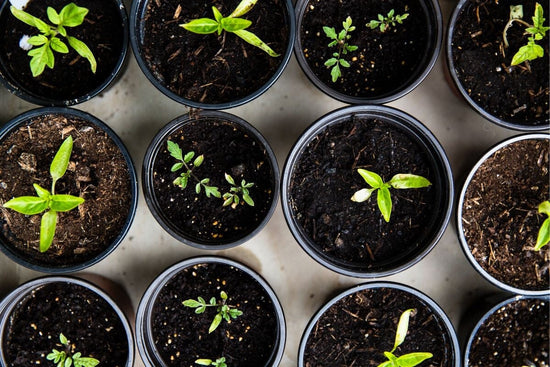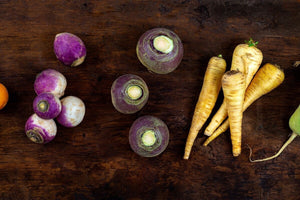Grow Ground Cherries from Seed for Tropical Flavor You'll Love!
Want an easy-to-grow fruit that falls at your feet when it’s ready to eat? Start growing ground cherries! These delicious heirloom fruits will delight your taste buds.

Quick Links
Heirloom ground cherries often get confused with other plants that look similar or have a similar name. However, we’re focused on the variety that is native to North America, Physalis pruinosa. This ground cherry is a member of the nightshade family, Solanaceae, which includes tomatoes, eggplants, and peppers.
Ground cherries are also called husk tomatoes. They grow inside a papery husk like tomatillos but are sweeter and turn golden orange when they are ripe. The flavor is tart and sweet, like a vanilla pineapple. They are used in both sweet and savory dishes. There are many ways to preserve ground cherries, but the most popular way to eat them is fresh from the ground.
How to Grow Ground Cherries from Seed
Ground cherry seeds can be started indoors 4 to 6 weeks before transplanting outside. Or 6 to 8 weeks before the last spring frost. They need plenty of time to germinate, grow, and develop fruits. Starting seeds indoors can help increase your harvest.
In a seed starting medium, plant ground cherry seeds ¼” deep.
Moisten the seeds with a spray bottle and keep the growing medium moist. Don’t allow the soil to dry out.
Keep the soil temperature between 70-80ºF.
Ground cherry seeds take 14 to 21 days to germinate.

Tips for Fail-proof Ground Cherry Seed Germination
Start seeds indoors 6-8 weeks before the last spring frost.
Plant seeds ¼” deep.
Water by misting until the seeds start to sprout. (14-21 days)
A dome can help retain moisture.
Once the seedlings are growing, water from the bottom to prevent damping off.
Use a grow light to give sufficient light and prevent leggy seedlings.
Use a heat mat to keep the soil temperature between 70-80ºF.
Thin seedlings when they are still small for stronger plants.
Like tomato plants, you can pot up as needed before transplanting outdoors.
How to Transplant Ground Cherry Seedlings Outdoors
Ground cherry plants can be transplanted outdoors when they have at least two sets of true leaves. However, if outside conditions are still too cold, ground cherry plants can be potted up and kept indoors until conditions are warm enough.
Ground Cherry plants are sensitive to frost. Wait to put them outside until all danger of frost has passed.
Before transplanting, take a week or two to harden off the young plants. This will help prevent transplant shock, which can result in stunted growth.
Space ground cherry plants 2 to 3 feet apart. These plants love to spread.
Because of their spreading nature and fruits that fall to the ground, you may want to use a ground cover fabric around the plants. You can cut holes for the plants and cover the rest of the area.
Just like their tomato cousins, you can plant the stems deep. The ground cherry plants will develop roots all along their stems. You can remove the bottom leaves to plant deeper, but keep enough leaves for photosynthesis.
This variety of ground cherries is an endangered heirloom that is making a comeback. It produces an abundance of golden fruits with a pineapple-vanilla flavor.
How to Maintain Ground Cherry Plants
Ground cherries grow best in full sun with nutrient-rich, well-draining soil. Temperatures between 55 and 90ºF are optimal, and they will stop setting fruit outside of that range.
Soil
Prepare your garden soil for growing ground cherries. They prefer slightly acidic soil with a pH range of 6.0 to 6.8. Ensure the soil is nutrient-rich and drains well. You can add well-rotted compost before planting.
Sun
Ground cherry plants grow best in full sun. This means 8 hours of direct sunlight. However, they can benefit from some afternoon shade in hot climates like the southwest.
Water
Keep ground cherry plants sufficiently watered so they will continue producing fruit. If the soil dries out, the ground cherry blossoms will fall off. This means no fruit will develop.
Check the soil and keep it moist. Adding a layer of mulch is an excellent way to retain soil moisture and prevent weeds.
Water the roots, not the leaves, to prevent fungal diseases from wet leaves.

Fertilizing
When you start with healthy soil, you don’t have to add additional fertilizer. However, extra fertilizer can increase growth and fruit production. As with other fruiting plants, you want to avoid too much nitrogen, which only results in more leaf growth. When the plants are producing fruit, you can apply a low-nitrogen fertilizer every 4 to 6 weeks.
Trellis and Supports
The use of trellises and supports can keep this sprawling plant healthier. Keeping ground cherry branches off the ground gives better air circulation. This takes more effort, but even the use of a tomato cage or a slanted piece of lattice works. This will also make it easier to find the delicious fruits when they fall off.
Solutions for pests and diseases
Although in the same family as tomatoes, ground cherries are not as susceptible to the same diseases. And their husks help to protect the fruit inside. You will still want to watch out for tomato hornworms, slugs, and other common pests.

Harvesting Ground Cherries
Ground cherries start off green but become golden yellow-orange when they are ripe. The sweeter they are, the more yellow they will be. But you won’t have to guess when it’s time to harvest your ground cherries. Ripe ground cherries will fall off the plant when they’re ready to eat. It's a good thing they already come in a paper bag!
Check underneath the plants every 2 or 3 days. With all that lush foliage, it's easy for the fruit to hide. You will want to pick them up and eat them before they start rotting. Also, they can self-seed, so beware.
When harvesting ground cherries, you can give the plants a little shake. This will encourage them to drop when you’re already out there gathering.
Store ground cherries in their husk until you are ready to eat them. They will last for up to 2 weeks in a cool spot. A temperature around 50ºF is best for long-term storage.
Ground cherries can be preserved in salsas, jams, and chutney. If you have an abundance of fruit, you can freeze them until you have time to make them into something else. Remove them from the husks before freezing.
Another way to preserve ground cherries is to dry them like raisins.

Can I grow ground cherries in pots?
Growing ground cherry plants in containers is one way to make it easier to gather your harvest. It can also be helpful to prevent self-seeding.
Use a pot that has a minimum depth of 8 inches and at least 1 foot wide. Ensure the pot has good drainage and plenty of sunshine. Keep the soil moist. Additional fertilizer may be needed during the fruiting season.
Ground cherries are a unique, easy-to-grow heirloom fruit. They can be a beautiful addition to any garden with their foliage and ever-changing papery husks.
Plant ground cherries from seed if you’re ready to try something fun and delicious in your garden!






Hi Linda, thanks for your questions. You can order seeds now, and they’ll be viable for spring planting. For your question about reseeding, I’ve had success with letting my ground cherries reseed. When they drop fruit, I leave them on the ground to decompose. In the spring, the seeds sprout and grow. Makes replanting very simple! That’s why I love heirloom seeds. You can also wash and dry seeds for storing. https://sowrightseeds.com/blogs/planters-library/how-to-save-the-seeds-from-your-favorite-plants
Thank you for the information for ground cherries. If i order seeds now will they be good to plant next spring? Do the plants reseed themselves or will i have to plant them again every spring?
Leave a comment